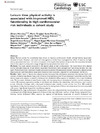Please use this identifier to cite or link to this item:
https://accedacris.ulpgc.es/jspui/handle/10553/73254
| Title: | Leisure time physical activity is associated with improved HDL functionality in high cardiovascular risk individuals: a cohort study | Authors: | Hernáez, Álvaro Soria-Florido, Maria Trinidad Castañer, Olga Pintó, Xavier Estruch, Ramón Salas-Salvadó, Jordi Corella, Dolores Alonso-Gómez, Ángel Martínez-González, Miguel Ángel Schröder, Helmut Ros, Emilio Serra Majem, Luis Fiol, Miquel Lapetra, José Gomez-Gracia, Enrique Fitó, Montserrat Lassale, Camille |
UNESCO Clasification: | 320501 Cardiología | Keywords: | Biomarkers Hdl Function Lifestyle Physical Activity |
Issue Date: | 2021 | Journal: | European Journal of Preventive Cardiology | Abstract: | Physical activity has consistently been shown to improve cardiovascular health and high-density lipoprotein-cholesterol levels. However, only small and heterogeneous studies have investigated the effect of exercise on high-density lipoprotein functions. Our aim is to evaluate, in the largest observational study to date, the association between leisure time physical activity and a range of high-density lipoprotein functional traits. Methods: The study sample consisted of 296 Spanish adults at high cardiovascular risk. Usual leisure time physical activity and eight measures of high-density lipoprotein functionality were averaged over two measurements, one year apart. Multivariable linear regression models were used to explore the association between leisure time physical activity (exposure) and each high-density lipoprotein functional trait (outcome), adjusted for cardiovascular risk factors. Results: Higher levels of leisure time physical activity were positively and linearly associated with average levels over one year of plasma high-density lipoprotein-cholesterol and apolipoprotein A-I, paraoxonase-1 antioxidant activity, high-density lipoprotein capacity to esterify cholesterol and cholesterol efflux capacity in individuals free of type 2 diabetes only. The increased cholesterol esterification index with increasing leisure time physical activity reached a plateau at around 300 metabolic equivalents.min/day. In individuals with diabetes, the relationship with cholesteryl ester transfer protein followed a U-shape, with a decreased cholesteryl ester transfer protein activity from 0 to 300 metabolic equivalents.min/day, but increasing from there onwards. Increasing levels of leisure time physical activity were associated with poorer high-density lipoprotein vasodilatory capacity. Conclusions: In a high cardiovascular risk population, leisure time physical activity was associated not only with greater circulating levels of high-density lipoprotein-cholesterol, but also with better markers of high-density lipoprotein functionality, namely cholesterol efflux capacity, the capacity of high-density lipoprotein to esterify cholesterol and paraoxonase-1 antioxidant activity in individuals free of diabetes and lower cholesteryl ester transfer protein activity in individuals with type 2 diabetes. | URI: | https://accedacris.ulpgc.es/handle/10553/73254 | ISSN: | 2047-4873 | DOI: | 10.1177/2047487320925625 | Source: | European Journal of Preventive Cardiology [ISSN 2047-4873], v. 28(12), p. 1392–140, (Noviembre 2021)1 |
| Appears in Collections: | Artículos |
SCOPUSTM
Citations
12
checked on Jun 8, 2025
WEB OF SCIENCETM
Citations
9
checked on Jun 8, 2025
Page view(s)
121
checked on Dec 28, 2024
Download(s)
457
checked on Dec 28, 2024
Google ScholarTM
Check
Altmetric
Share
Export metadata
Items in accedaCRIS are protected by copyright, with all rights reserved, unless otherwise indicated.
